UV monitoring and VITA-D biodosimeter
The most important results
-
The new spectral selective method of dosimetry of biologically active UV radiation was proposed, and Prof. I. Terenetskaya received the award for the paper presented in Los-Angeles at Biomedical Optics'1994. Method is based on the spectral monitoring of previtamin D photosynthesis (in vitro) for estimation of the UV "antirachitic" activity (in situ).
In view of significant difference between the CIE erythema and "Vitamin D" action spectra, commonly used broad-band radiometers with spectral sensitivity corresponding to the CIE erythema action spectrum are unable to measure the vitamin D synthetic capacity of sunlight or an artificial UV source. -
The availability of a mathematical model of previtamin D photosynthesis enables prediction of "antirachitic" solar UV radiation throughout the globe. As UV irradiation of provitamin D results in the formation of previtamin D, which is immediate precursor of vitamin D, previtamin D accumulation over UV exposure determines the biologically effective dose. The FASTRT program was used for the calculations of solar UV radiation on the earth’s surface.
-
We provided the tested measurements of previtamin D synthetic capacity of sunlight during 3 years in Kiev, Ukraine. For the first time Dr. I. Gvozdovskyy carried out the same measurements during 1 year at the Vernadsky Antarctic station.
-
At last we have studied effects of UV irradiation on the selective reflection of cholesteric LC’s doped by provitamin D with the aim of monitoring the vitamin-D synthetic capacity of sunlight and/or artificial UV sources. The optimum LC composition which provided the largest shift of the selective reflection band (~150 nm) under UV irradiation was defined. Linear correlation of the shift with previtamin D accumulation in ethanol was established and that formed basis for UV biosensor with visual estimation of previtamin D accumulation during an exposure.The obtained results also can be applied in optical information storage, LC display technology, etc.
 |
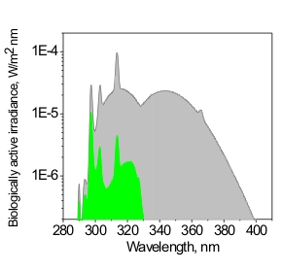 |
| The 7-DHC absorption spectrum in relative units and CIE erythema action spectrum in relation to the irradiation spectrum of the UV lamp Cleoperformance 100W-R, and calculated erythemic (grey) and ‘antirachitic’ (green) biologically active irradiances of the lamp. | |
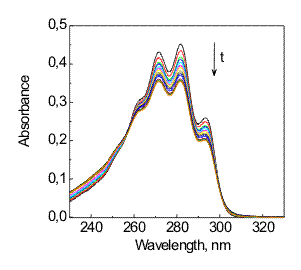 |
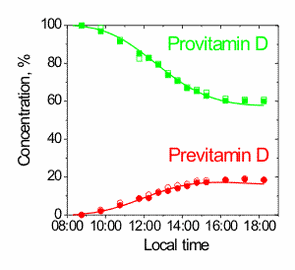 |
| Field test Greece. Spectral and concentration (symbols – experimental data, lines – calculated data) kinetics of provitamin D photoreaction. | |
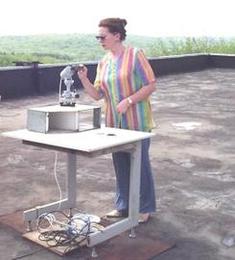 |
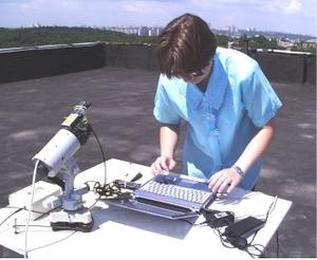 |
| Prof. Irina Terenetskaya and Dr. Tetiana Orlova take the measurements of previtamin D synthetic capacity of sunlight in Kiev, Ukraine. |
|
| Season effect on previtamin D photosynthesis in Kiev and Antarctica. |
|
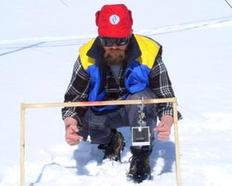 |
 |
| Dr. Igor Gvozdovskyy installs quartz cuvettes with ethanol solution of 7-DHC for exposure to sunlight at the Vernadsky Antarctic station. | |
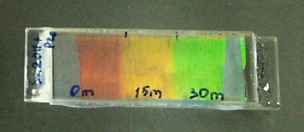 |
UV-induced conversion of provitamin D in cholesteric LC is accompanied by the change of cholesteric pitch and, as a result, by the colour change. |
I.P.Terenetskaya "Provitamin D photoisomerization as possible UVB monitor: kinetic study using tunable dye laser", SPIE Proceedings of the Int. Conf. "Biomedical Optics'94", January 22-28, 1994, Los Angeles, USA, Vol.2134B “Ultraviolet Radiation Hazards”, pp.135-140.
I.Terenetskaya "Vitamin D Biodosimeter: monitoring of antirachitic activity of solar UVB radiation", EC Air Pollution Research Report 71 "Biological UV dosimetry, a tool for assessing the impact of UV radiation on health and ecosystems", 1999, pp.158-168.
A.R.Webb, I.P.Terenetskaya "Combined study of antirachitic solar UVB radiation by spectroradiometer and "Vitamin D" biodosimeter", In: "Biologic Effects of Light 1998": Proceedings of a symposium, Basel, Switzerland, Nov.1-3, 1998 / Editors, Michael F. Holick and Ernst G. Jung, Kluver Acad. Publishers, 1999, pp.153-155.
Irina P.Terenetskaya "The new method of UV dosimetry based on an in vitro model of previtamin D photosynthesis", Internet Virtual Conference "Protection Against the Hazards of UVR", Jan.18-Feb.5, 1999.
O.N.Galkin, I.P. Terenetskaya "Vitamin D" biodosimeter: basic characteristics and prospect applications" J.Photochem.Photobiol. B:Biology, 1999, Vol.53, №1, pp.12-19.
I.Terenetskaya "Spectral Monitoring of Biologically Active Solar UVB Radiation Using an In Vitro Model of Vitamin D Synthesis", Talanta, 2000, Vol.53, №1, pp.195-203.
I. Bolsee, A. R. Webb, D. Gillotay, B. Dorschel, P. Knuschke, A. Krins, and I. Terenetskaya "Laboratory facilities and recommendations for the characterization of biological ultraviolet dosimeters", Applied Optics, 2000, Vol.39, No.16, pp.2813-2822.
Irina Terenetskaya "A possibility of ozone depletion monitoring in conditions of opaque atmosphere using ‘D-dosimeter’", In: Ultraviolet Ground and Space -based measurements, Models and Effects. Eds Slusser JR, Herman JR and Gao W., SPIE Proc., 2002, Vol.4482, pp.305-312.
Irina Terenetskaya "Duality of solar UV-B radiation and relevant dosimetry: vitamin D synthesis versus skin erytema», (#4896-25), In: Protection Against the Hazards of UVR, Hangzhou, China, 4896, edited by W. Gao, G. Shi, K. Shibasaki, and J. Slusser, SPIE Proc., 2003, Vol.4896, pp.144-150.
I. Terenetskaya "Solar UV-B dosimetry in situ with ‘D-dosimeter’: effect of ozone depletion on the vitamin D synthetic capacity of sunlight", Agriculture and Forest Meteorology, 2003, Vol.120, pp.45-50.
Terenetskaya I., Orlova T. "UV radiation, vitamin D and cancer: how to measure the vitamin D synthetic capacity of UV sources?", Proc. SPIE, 2005, Vol.5969, pp.465-471.
Orlova T.N., Terenetskaya I.P. "UV-biosensor for visual indication of vitamin D synthesis", Proc. SPIE, 2008, Vol.7003, p.70031O.
Terenetskaya I.P., Orlova T.N. "Personal UV biodosimeter for healthy indoor tanning", Proc. SPIE, 2008, Vol.6991, p.69911F.